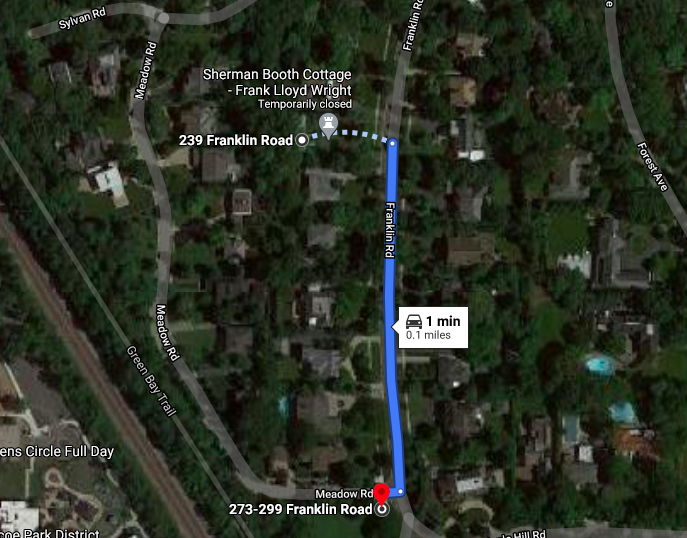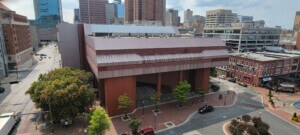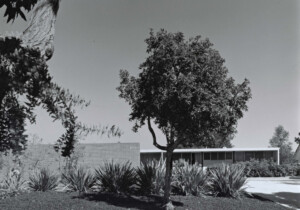Following a white-knuckle stretch in which a compact and somewhat obscure Frank Lloyd Wright-designed home in the North Shore Chicago suburb of Glencoe, Illinois, was threatened with demolition not once but twice in less than two years, preservationists can finally breathe a sigh of relief.
The humble abode in question, the Booth Cottage, was painstakingly lifted and loaded onto a trailer and relocated to safer pastures within Glencoe this morning as part of a planned (but delayed due to the COVID-19 crisis) relocation spearheaded by the Glencoe Historical Society (GHS). The low-key spectacle of a rare and previously endangered Frank Lloyd Wright building in its entirety (save for later structural additions including an attached garage) being transported by tow dollies down a suburban street, not surprisingly, drew a decent crowd of well-wishing onlookers.
Per NBC 5 Chicago, residents of the village were expected to watch the move, which took less than an hour, but were reminded by officials to wear masks and social distance while doing so.
“There have been a lot of unfortunate and unavoidable delays due to everything that has been happening the past few months, but it is finally going to happen,” Karen Ettelson, co-president of the Glencoe Historical Society, told the Chicago Tribune.
Built in 1913, the 1,100-square-foot—later expanded by 700 feet—one-story cabin served as the temporary residence of Sherman Booth, an attorney for Wright, and his wife Elizabeth Booth, a well-known suffragist, while the couple’s larger permanent home, also designed by Wright in his signature-at-the-time Prairie Style, was being completed in the nearby Ravine Bluffs development. The Booth residence was the largest of the six Wright-designed homes built in Ravine Bluffs, an affluent enclave that featured the only bridge designed by Wright over the course of his career. (The original bridge has since been replaced with a replica.)
Today’s relocation was, as noted by Landmark Illinois, not the first time the structure has been moved. After the Booths transitioned from the cabin to their permanent home in late 1916 or early 1917, the cottage was relocated from a parcel at 201 Franklin Road to its longtime location at 239 Franklin Road.
Although designed as interim digs, the unfussy and flat-roofed Booth Cottage is not without significance as an early precursor to Wright’s mid-career, middle-class-targeting Usonian homes that emphasized efficiency, economy, and a streamlined construction process.
The Booth Cottage’s modest scale, location on a large coveted lot, and relative anonymity in a region chock-full of Wright masterworks has made it an easy target for demolition in recent years despite being declared a local landmark by the Village of Glencoe in 1996. If it had been demolished, as was planned last year, it would have been the first Wright-designed residential building to be razed since 2004 when the W.S. Carr Cottage in Grand Beach, Michigan, came face to face with the wrecking ball. However, Wright’s non-residential projects haven’t fared quite as well; the Lockridge Medical Clinic building in Whitefish, Montana, was torn down in 2018.

The Booth Cottage, however, evaded the same fate of the Carr summer home thanks to the efforts of the home’s newest owner, the nonprofit GHS. Working in collaboration with Glencoe Park District, the GHS ironed out a 99-year-lease at the nearby Park 7N, where the cottage will now occupy a small section of the park at a rate of $1 per year. The Glencoe Park District Board of Commissioners voted to approve the land lease agreement, which didn’t come without some local pushback, in January of this year.
“Over the last six months as they raced against the clock, they [the GHS] have thoughtfully considered this project and have responsibly conducted their due diligence,” said Frank Lloyd Wright Building Conservancy executive director Barbara Gordon in a statement released after the deal was finalized and it became clear that the Booth Cottage would be saved. “We also thank the Village of Glencoe management and the Park District for working with the Historical Society to find a solution that would keep this building in Glencoe just a short distance from its current location in the Ravine Bluffs neighborhood.”
Once established at the new site, the cottage will eventually be restored to its original state and opened to the public as a museum.











